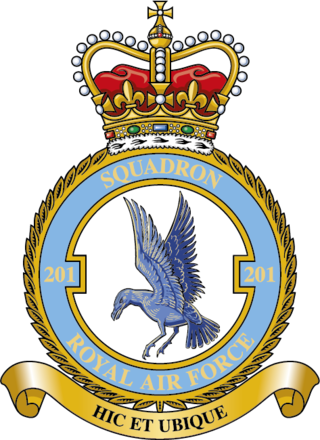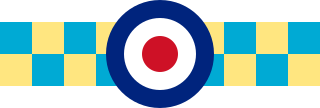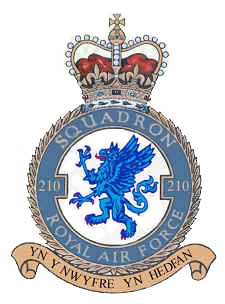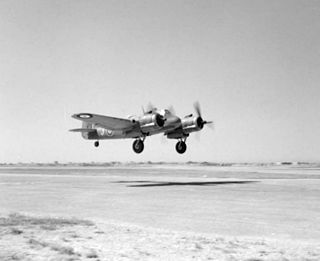
No. 206 Squadron is a Test and Evaluation Squadron of the Royal Air Force. Until 2005 it was employed in the maritime patrol role with the Nimrod MR.2 at RAF Kinloss, Moray. It was announced in December 2004 that 206 Squadron would disband on 1 April 2005, with half of its crews being redistributed to Nos. 120 and 201 Squadrons, also stationed at Kinloss. This was a part of the UK Defence Review called Delivering Security in a Changing World; the Nimrod MR.2 fleet was reduced in number from 21 to 16 as a consequence.

Number 201 Squadron is a squadron of the Royal Air Force. It currently operates the Boeing Poseidon MRA1 from RAF Lossiemouth, Moray.

Number 230 Squadron Royal Air Force is a Royal Air Force (RAF) flying squadron, currently based at Medicina Lines in Brunei Darussalam, part of British Forces Brunei, operating the Westland Puma HC2. The squadron was previously part of Royal Air Force Germany (RAFG), operating the Puma HC1 there from 1980. Following the drawdown of the British Armed Forces in Germany at the end of the Cold War, the squadron disbanded on 30 April 1992. This was short-lived however, and the squadron reformed at RAF Aldergrove on 4 May 1992, again with the Puma HC1.

No. 202 Squadron of the Royal Air Force is the maritime and mountains training element of the No.1 Flying Training School, operating the Airbus Helicopters H145 Jupiter.
No. 119 Squadron RAF was a squadron of the Royal Air Force (RAF), flying with Coastal Command during the Second World War. It was the only RAF unit flying the Short G class and Short C class flying boats.

No. 543 Squadron RAF was a photographic reconnaissance squadron of the Royal Air Force, active in two periods between 1942 and 1974.

No. 245 Squadron was a squadron of the Royal Air Force. It flew as an anti-submarine squadron during World War I and as a fighter squadron during World War II. After the war it was first a jet-fighter squadron and its last role was as a radar-calibration unit.
No. 282 Squadron was a Royal Air Force air-sea rescue squadron during the Second World War.
No. 281 Squadron was a Royal Air Force air-sea rescue squadron during the Second World War.
No. 684 Squadron RAF was a photo-reconnaissance squadron of the Royal Air Force from 1943 to 1946.

No. 210 Squadron was a Royal Air Force unit established in the First World War. Disbanded and reformed a number of times in the ensuing years, it operated as a fighter squadron during the First World War and as a maritime patrol squadron during the Spanish Civil War, the Second World War and the Cold War before it was last deactivated in 1971.
No. 158 Squadron RAF was a World War I proposed ground attack squadron that did not become operational in time to see action, and a World War II bomber squadron. After World War II had ended in Europe the squadron operated in the transport role until disbandment in December 1945.

No. 235 Squadron RAF was an anti-submarine warfare squadron of the Royal Air Force which disbanded during July 1945. It was active in both the First World War, forming during August 1918 and disbanding in February 1919, and in the Second World War, reforming at the end of October 1939, and served as a squadron in RAF Coastal Command.
No. 204 Squadron was a Royal Air Force unit first formed in March 1915 as No.4 Squadron Royal Naval Air Service.

Number 209 Squadron of the British Royal Air Force was originally formed from a nucleus of "Naval Eight" on 1 February 1917 at Saint-Pol-sur-Mer, France, as No. 9 Squadron Royal Naval Air Service (RNAS) and saw active service in both World Wars, the Korean War and in Malaya. The use of the squadron number ceased in 1968 and it has not been reused since by an RAF squadron. However the number, badge and motto is in current service within the RAF Air Cadets at 209 Squadron ATC in Nottinghamshire.
No. 680 Squadron RAF was a photo-reconnaissance squadron of the Royal Air Force, active during the Second World War.

No. 275 Squadron RAF was a Royal Air Force air-sea rescue squadron that served between 1941 and 1959.
No 295 Squadron RAF was an airborne forces and transport squadron of the Royal Air Force during World War II. It was the first unit to be equipped with the Armstrong Whitworth Albemarle transport and glider tug aircraft.
No. 137 Squadron RAF existed briefly as a day bomber unit in World War I but never became operational. During World War II it flew as one of the two Whirlwind squadrons before converting to Hurricane Mk.IV fighter-bombers and later the Hawker Typhoon in the same role. The squadron was disbanded in August 1945.
No. 240 Squadron RAF was a Royal Air Force flying boat and seaplane squadron during World War I, World War II and up to 1959. It was then reformed as a strategic missile squadron, serving thus till 1963.
















